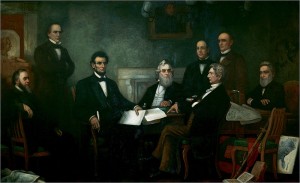 No doubt everyone in the Lincoln world has heard repeatedly about the document we’ve all come to know as the “blind memorandum.” But what about the “reveal party” when Lincoln showed his cabinet what he had written? That event happened on November 11, 1864.
No doubt everyone in the Lincoln world has heard repeatedly about the document we’ve all come to know as the “blind memorandum.” But what about the “reveal party” when Lincoln showed his cabinet what he had written? That event happened on November 11, 1864.
As a quick reminder, on August 23, Lincoln had asked each of his cabinet secretaries to sign the outside of a sealed envelope. He didn’t show them what was inside, only promised to reveal it to them at a later date – after the November 8 presidential election. While this document is so familiar to us today, it turns out that it went unremarked at the time. Allen Guelzo, writing in Lincoln Lore, noted that neither Gideon Welles or Edward Bates – from whose contemporaneous diaries we have gained great insights – nor either of Lincoln’s personal secretaries, made any mention of it. In fact, it wasn’t until 1877 that any mention of the “blind memorandum” was made by anyone. That is when Gideon Welles, whose diary seemed to grow over time, wrote an article in Galaxy magazine in which he described an anxious Lincoln initiated:
a request that I would write my name across the back of it. One or two members of the Cabinet had already done so. In handing it to me he remarked that he would not then inform me of the contents of the paper enclosed, had no explanation to make, but that he had a purpose, and at some future day I should be informed of it, and be present when the seal was broken.
As Guelzo notes, the reverse of the “blind memorandum” does in fact contain the signatures of all seven cabinet secretaries, with “Welles fourth in order after Seward, Fessenden and Stanton, and dated in Lincoln’s hand again.”
Flash forward to November 11. Three days after his surprisingly easy reelection, Lincoln had a big blind memorandum reveal party. While no one bothered to mention the earlier signing requests, this time John Hay captured the moment in his diary:
At the meeting of the Cabinet today, the President took out a paper from his desk and said, “Gentlemen do you remember last summer I asked you all to sign your names on the back of a paper of which I did not show you the inside? This is it. Now, Mr Hay, see if you can get this open without tearing it!”: He had pasted it up in so singular [a] style that it required some cutting to get it open.
Lincoln then read the memorandum:
Executive Mansion
Washington, Aug. 23, 1864.
This morning, as for some days past, it seems exceedingly
probable that this Administration will not be re-elected. Then it
will be my duty to so cooperate with the
GovernmentPresident-elect,as to save the Union between the election and the inauguration; as he
will have secured his election on such ground that he can not
possibly save it afterwards.
The immediate reaction of the cabinet was somewhat confused. Why would Lincoln have written this, then gotten their endorsements without showing it to them? Lincoln, without explaining the secrecy, did explain that he would attempt to work with presumed President-Elect McClellan to raise as many troops as he could for a final trial to win the war, and Lincoln would use his power of office to aid in saving the Union. The cabinet was skeptical that McClellan would have held up his part of such a bargain, as was Lincoln. According to Hay’s diary entry, Seward noted that McClellan would simply respond to Lincoln’s offer with “Yes, Yes,” and the next day also “’Yes-Yes’ & so on forever and would have done nothing at all.”
Lincoln, who had fired McClellan earlier in the war for “having the slows,” knew that Seward was right. “At least,” Lincoln said, according to Hay, “I should have done my duty and have stood clear before my own conscience.”
After the big reveal, the “blind memorandum” took on a celebrity status of its own. Bates asked for a copy, then Welles wanted one too, “then everybody” wanted one, according to a letter Hay wrote Nicolay years later.
[Photo from Wikimedia Commons, “First Reading of the Emancipation Proclamation” by Francis Bicknell Carpenter]

Lincoln: The Fire of Genius: How Abraham Lincoln’s Commitment to Science and Technology Helped Modernize America is available at booksellers nationwide.
Limited signed copies are available via this website. The book also listed on Goodreads, the database where I keep track of my reading. Click on the “Want to Read” button to put it on your reading list. Please leave a review on Goodreads and Amazon if you like the book.
You also follow my author page on Facebook.
David J. Kent is Immediate Past President of the Lincoln Group of DC and the author of Lincoln: The Fire of Genius: How Abraham Lincoln’s Commitment to Science and Technology Helped Modernize America and Lincoln: The Man Who Saved America.
His previous books include Tesla: The Wizard of Electricity andEdison: The Inventor of the Modern World and two specialty e-books: Nikola Tesla: Renewable Energy Ahead of Its Time and Abraham Lincoln and Nikola Tesla: Connected by Fate.




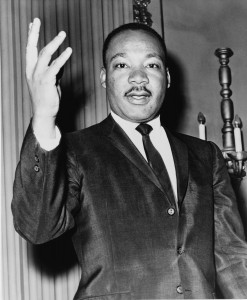 As we celebrate the birth of Dr. Martin Luther King, MLK, it’s impossible not to reminisce on the connection with Abraham Lincoln, ABE. The two men are linked forever because of Lincoln’s emancipation proclamation and King’s reference to it in his “I have a dream” speech.
As we celebrate the birth of Dr. Martin Luther King, MLK, it’s impossible not to reminisce on the connection with Abraham Lincoln, ABE. The two men are linked forever because of Lincoln’s emancipation proclamation and King’s reference to it in his “I have a dream” speech.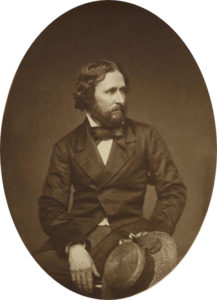 On September 5, 1861, President Abraham Lincoln had a problem, and that problem was John C. Fremont. Seeking a solution, Lincoln conferred with Commanding General of the U.S. Army Winfield Scott. He wanted some input on what to do with Fremont. Here is what I wrote up for the
On September 5, 1861, President Abraham Lincoln had a problem, and that problem was John C. Fremont. Seeking a solution, Lincoln conferred with Commanding General of the U.S. Army Winfield Scott. He wanted some input on what to do with Fremont. Here is what I wrote up for the 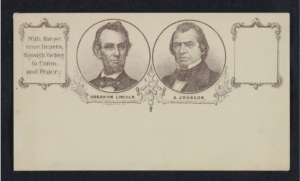 Today, July 26, marks the 75th anniversary of the opening of the Lincoln Papers at the Library of Congress.
Today, July 26, marks the 75th anniversary of the opening of the Lincoln Papers at the Library of Congress.


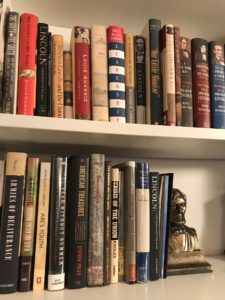 Even when I’m trying to reduce the number of books in my house I end up with more. My Abraham Lincoln book acquisition total for 2022 is 34, and that number includes some books that are Lincoln-ish. You can read about past years acquisitions by
Even when I’m trying to reduce the number of books in my house I end up with more. My Abraham Lincoln book acquisition total for 2022 is 34, and that number includes some books that are Lincoln-ish. You can read about past years acquisitions by 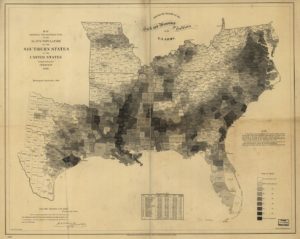 Lincoln took a scientific approach to military strategy. The Anaconda plan’s focus was on securing the coastlines and the Mississippi River. Recognizing New Orleans as the hub of the cotton trade and commerce, Lincoln saw it as the first port to be targeted for blockade. He also hoped to block southern ship traffic from Charleston, South Carolina to cut off Confederate attempts to woo Great Britain and France to their side. Helping him make this happen was Alexander Dallas Bache and the Coast Survey. The Coast Survey had been authorized by Thomas Jefferson, and Bache, who was Benjamin Franklin’s great-grandson, was quick to send nautical charts of the Chesapeake Bay to Lincoln. He also forwarded two terrestrial maps produced by the Survey that had far-reaching influence on Lincoln’s decisions on emancipation and military strategy.
Lincoln took a scientific approach to military strategy. The Anaconda plan’s focus was on securing the coastlines and the Mississippi River. Recognizing New Orleans as the hub of the cotton trade and commerce, Lincoln saw it as the first port to be targeted for blockade. He also hoped to block southern ship traffic from Charleston, South Carolina to cut off Confederate attempts to woo Great Britain and France to their side. Helping him make this happen was Alexander Dallas Bache and the Coast Survey. The Coast Survey had been authorized by Thomas Jefferson, and Bache, who was Benjamin Franklin’s great-grandson, was quick to send nautical charts of the Chesapeake Bay to Lincoln. He also forwarded two terrestrial maps produced by the Survey that had far-reaching influence on Lincoln’s decisions on emancipation and military strategy.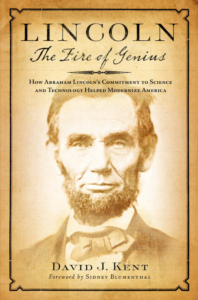
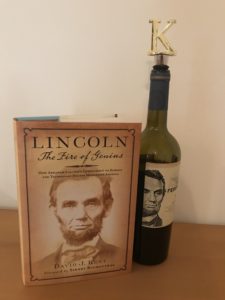 I was interviewed for the summer 2022 issue of The Lincolnian, the newsletter of the Lincoln Group of DC. This is Part 3, the final part. Here is
I was interviewed for the summer 2022 issue of The Lincolnian, the newsletter of the Lincoln Group of DC. This is Part 3, the final part. Here is  The Lincoln Memorial reaches its centennial this month and this past week was the culmination of a year’s worth of work to celebrate the iconic structure’s 100th birthday. Around this time last year, the Lincoln Group of DC, of which I am the current president, decided that we must have a magnificent event on the Memorial steps. We had done something similar in 2015 for the sesquicentennial of Abraham Lincoln’s second inaugural speech so we followed the basic format. There were differences of course. We couldn’t really have a Lincoln reenactor for a memorial to his life and death, especially since it wasn’t dedicated until 57 years after his assassination. We also couldn’t just recapture the Civil War theme, nor did we want to exactly recapture the segregationist Jim Crow-era time of 1922. Plus, we would be working with the National Park Service, which would prefer not to be overly controversial. Still, there were issues from that 1922 dedication we wanted to address and there has been 100 years of history we wanted to show.
The Lincoln Memorial reaches its centennial this month and this past week was the culmination of a year’s worth of work to celebrate the iconic structure’s 100th birthday. Around this time last year, the Lincoln Group of DC, of which I am the current president, decided that we must have a magnificent event on the Memorial steps. We had done something similar in 2015 for the sesquicentennial of Abraham Lincoln’s second inaugural speech so we followed the basic format. There were differences of course. We couldn’t really have a Lincoln reenactor for a memorial to his life and death, especially since it wasn’t dedicated until 57 years after his assassination. We also couldn’t just recapture the Civil War theme, nor did we want to exactly recapture the segregationist Jim Crow-era time of 1922. Plus, we would be working with the National Park Service, which would prefer not to be overly controversial. Still, there were issues from that 1922 dedication we wanted to address and there has been 100 years of history we wanted to show.





